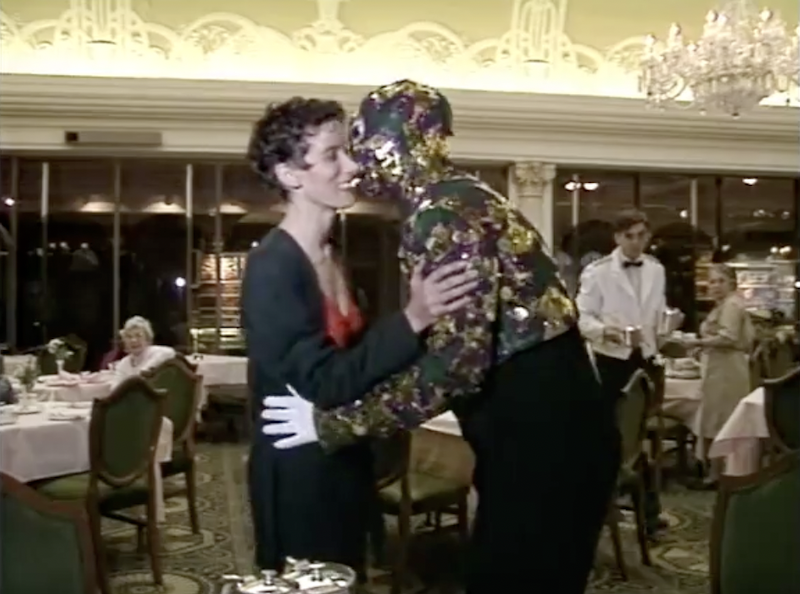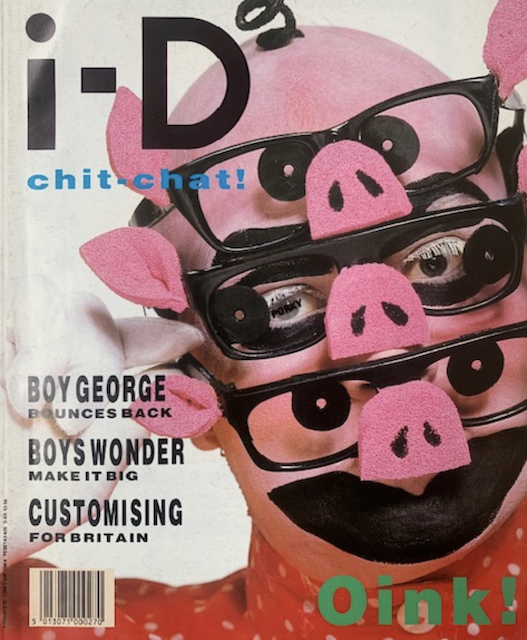
Tea with Leigh
Leigh Bowery (1961-1994), a man of many costumes and guises that some might have described as Drag back then - is back on the stage! An exhibition centering his unique performance of his individuality, along with many '80s looks, icons of the time and general nostalgia for post punk sensibility, will take place at the Fashion and Textiles Museum 4th October to 9th March 2024.
I find myself channelling memories of taking tea with Leigh Bowery in the Harrods Tea Rooms
Currently, for those of us now coming to the end of our working practice, the cultural focus is suddenly on those early days of our fashion careers. In addition to the above, Tate Modern will also host a Leigh Bowery Retrospective with the Design Museum looking at The Blitz Club. As working life for me began in 1982 at i-D Magazine, where I stayed for 6 years, it's a time I hold affectionately. But what is it about those times that continues to fascinate? For me, it's an era that reeks of authentic identity politics when viewed through the lens of pre-internet and early tech beginnings that would foreground a nascent UK fashion industry evolution.
"We are all born naked the rest is drag"
We are all born naked and the rest is drag. Ru Paul said this in his 1995 memoir. He also talked about the lack of role models for a gay, gender non-binary African-American man from the American Midwest. These days we understand role model's are vital for shining a light on the path less trodden. This learning will be fortified throughout my working life. The latest exhibition: Outlaws: Fashion Renegades of the '80s presents an aesthetic where the language of hedonistic excess to create fashion, art and popular culture was the norm.
Leigh epitomises this era for many of us - one where image allowed for an alter ego, counter cultural rebellion, the release of an oppressed truth, or simply a new language. This seemed unremarkable at the time, we had all normalised the Taboo culture of ‘dress as though your life depends on it, or don’t bother.’
So I find myself channelling memories of taking tea with Leigh Bowery in (86 0r 87) in the Harrods Tea Rooms (of all places). I was interviewing him about his style. Side note readers, he treated other tea drinkers on the day to an impromptu Catwalk Show as the film footage below shows.
It was natural then, when I moved to a more mainstream BBC TV vehicle, that as Leigh and I sat down to talk, we would be accompanied by camera's to record his unique take on style, for the mainstream audience that tuned into the BBC's Clothes Show every week.
This spectacle would have aired when most of middle England was doing their best to get to grips with Larry Grayson - the then closeted but (sartorially very 'normcore') TV host of The Generation Game and master of the 'prime-time' double entendre.
Leigh, no doubt blew their minds.
I had known Leigh since he landed from Australia. It was impossible not to spot him and we featured him and his clubland patrons regularly (at Taboo) in i-D Magazine. A regular goer myself, to the Thursday night pop up in the basement of the Maximus club in Piccadilly, he told me he had been working in a Melbourne burger bar effectively stranded over the other side of the world. Then he happened upon a 'life saving,'early issue of i-D. Suddenly he had a powerful calling to get himself to Soho where he would be with 'his people.' Little did he know he would make the cover of said publication in a very short time.
Little did he know he would make the cover in a very short time.
We were all experimenting with clothing statements back then - this was our social networking; an optical telegraph if you like, that communicated our thoughts, politics, musical tastes and much more. But Leigh, who would take this much further than posing as we simply did, in home-made garb, or designer toiles lent by fashion school friends, devoted himself to complete transformation. As Dylan Jones writes so well in ES magazine 'Bowery dedicated himself to the total theatricalisation of the self using the night club as his stage.'
He was a big man; huge in heels, his fleshy body covered in sequins, florals and colour (and that includes full fabric face mask, thick make-up, gloves and thick tights over ample legs).
And in opposition to standard fashion hyperbole - conical breasts, square shoulders and the Westwood mini crini - basic trends of the day that only sylph-like bodies presented from the runway, he embodied fetish, drag, cross dressing and surrealism on his non-conformist body. "I couldn't do this anywhere else but in London," he said as we poured the tea and discussed fabrics and fit.
I couldn't do this anywhere else but in London he said as we poured tea and discussed fabrics and fit.
I've been told by many since that it was their favourite piece of Clothes Show footage. One reason given is that he and I talked simply about his approach to clothes, image and identity (my fave topic) and at a time where other creative individuals were denigrated on mainstream TV. Remember the live, Sue Lawley, take down of an unsuspecting Vivienne Westwood invited as a guest to talk about her collections? There was little tolerance for individuality back then.
This took place in 1988. Homophobia was rife, racism was standard, no one in my circle had even begun to use or understand cis and trans pre-fixes and neuro-divergence was a very long way from being common parlance. Even Vivienne Westwood was a threat to conservative tastes. Sadly most TV programming (with only 4 channels to choose from) was culturally numbing.
This at a time homophobia was rife, and no one in my circle had even begun to use or understand cis and trans pre-fixes. Even Vivienne Westwood was a threat to conservative tastes. Most TV programming (with only 4 channels) was culturally numbing
The Clothes Show (which spanned '86-'98) although mainstream (we had up to 13 million viewers in the UK and reached the homes of 157 million viewers through BBC World Service), was allied to a more exotic and at times fluid breed of humans. This pleases me. People are much more than their sexuality or their bodies as we know and I like to think that in our way we spoke to people seeking authenticity. Jason Jones, a Trinidadian Activist for gay rights, confirmed this very recently when he told me at a party, (after giving me the hug you give a long lost friend), how much The Clothes Show had meant to him as a young man.
For Jason and others growing up in the fundamentalist, Christian homophobic communities overseas, to see non-conformist male creatives casually celebrated in the way that we did regularly on the programme was crucially validating.
We've all come a long way. And as an early proponent of automedia 'the enactment of a life story in a new media environment' (Rak, J. 2017), Leigh Bowery you are celebrated many times over. But then I'm sure you knew you would be.
Outlaws: Fashion Renegades of 80s London.
The Fashion and Textiles Museum
Tickets £12.65
4th Oct - 9th March



